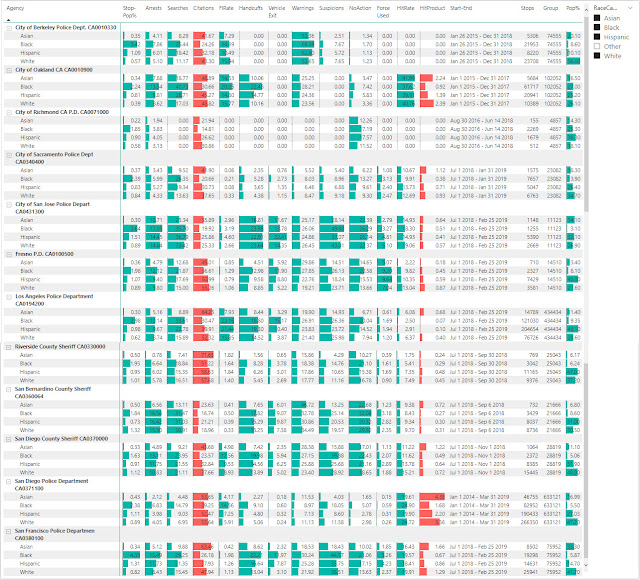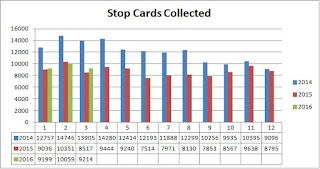Self inflicted wounds or the result of a data meat axe?
I
have received tables that purportedly represent citations issued, by the SDPD,
for the period Jan 2015 through December 2015. It contains 103,109 Vehicle Code-related
records. I have taken a mighty leap and concluded that these records are all the
result of traffic stops. That is where the sense ceases.
|
Month
Year
|
Records
|
Computed
Citations
|
Actual
Citations
|
Difference
|
Projected
Stops
|
Multiplier
|
Percentage
Missing
|
Percentage
Cited
|
|
Jan-15
|
9133
|
5200
|
9040
|
-3840
|
16443
|
0.45023
|
73.85
|
56.94
|
|
Feb-15
|
10584
|
6462
|
9068
|
-2606
|
16494
|
0.45023
|
40.33
|
61.05
|
|
Mar-15
|
9676
|
5169
|
6899
|
-1730
|
12548
|
0.45023
|
33.47
|
53.42
|
|
Apr-15
|
10870
|
5991
|
7569
|
-1578
|
13767
|
0.45023
|
26.34
|
55.11
|
|
May-15
|
10700
|
5425
|
9469
|
-4044
|
17223
|
0.45023
|
74.54
|
50.7
|
|
Jun-15
|
10098
|
4482
|
7910
|
-3428
|
14387
|
0.45023
|
76.48
|
44.39
|
|
Jul-15
|
10017
|
4622
|
8387
|
-3765
|
15255
|
0.45023
|
81.46
|
46.14
|
|
Aug-15
|
9055
|
4688
|
10018
|
-5330
|
18222
|
0.45023
|
113.69
|
51.77
|
|
Sep-15
|
8047
|
4488
|
9163
|
-4675
|
16666
|
0.45023
|
104.17
|
55.77
|
|
Oct-15
|
8783
|
5373
|
10186
|
-4813
|
18527
|
0.45023
|
89.58
|
61.17
|
|
Nov-15
|
9638
|
6036
|
8043
|
-2007
|
14629
|
0.45023
|
33.25
|
62.63
|
|
Dec-15
|
8820
|
5348
|
7357
|
-2009
|
13381
|
0.45023
|
37.57
|
60.63
|
|
115421
|
63284
|
103109
|
-39825
|
187542
|
54.9767
|
Records,
Computed Citations and related computations are produced from Vehicle Stop Data
(VSD.) Actual Citations, as
mentioned above, are said to come from a discrete are set of tables and
databases (see CPRA
16-998.) Shocking and revealing are the instances where the actual
citations exceed the number of stop records[1].
It is especially so since we know, from experience, that less than 60% of stops
result in the issuance of a citation. Accordingly, from these averages, we may
project mathematically and conclude that Vehicle Stop data entry or compliance
rates are appalling low. Projections
suggest over 70,000 records are missing; a number in keeping with the radical
and unexplained diminishment in data collection/entry first identified, and
disclosed to you, in December 2014.
There is no need to
attempt to understand why the counts, in citations, from the VSD tables are so massively different from the numbers fetched
from the SDPD citation tables and databases (39825.) That is a fool’s
errand and I have enough to run. So, I direct you instead to the key and other conclusions of the Cordner Report, and its caution, and
conclusions that, for me, are intended to be admonitions, to you. I embed
excerpts from them below as I recall my earlier communications, to some of you,
regarding self-inflicted wounds and their usefulness.
.
The
Cordner
Report At page 1
Officers completed 121,013 vehicle
stop forms in 2001, a 28% decrease from the previous year. This very
substantial decrease raises serious questions about the validity of the vehicle
stop data.
The
Cordner
Report At page 2
One division did have 3,000 more
stops than citations, but another had 7,000 fewer stop
forms than citations. Of particular concern, it would appear from the
data that non-compliance in completing stop forms was a bigger problem in more ethnically-diverse and less-affluent divisions,
possibly skewing the data.
And, again in the Cordner
Report At page 2
Key Issues The substantial decrease in stop forms in 2001,
and resulting concerns about the representativeness of the data, severely limit
the confidence that can be placed in any findings and conclusions.
The authors have tried to be cautious in interpreting the data.
Please
feel free to re-use the above text, by substituting 2015 wherever 2001 appears.
The difference is that you were
forewarned.
Other issues related to these
citations will be addressed in the coming week.



Comments
Post a Comment